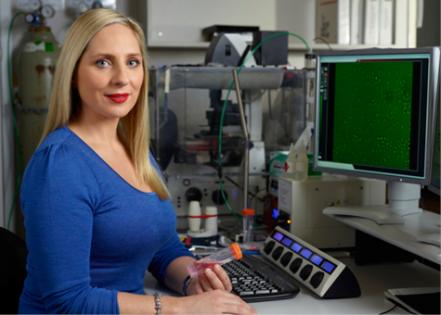For a girl from Ballarat, Misty’s career so far has been quite a journey.
Along the way she been mentored by Nobel Prize-winning immunologist Professor Peter Doherty and become the first Indigenous Australian to attend either Oxford or Cambridge.
Now working with Professor Joe Trapani as a National Health and Medical Research Council (NHMRC) postdoctoral fellow in the Cancer Cell Death laboratory at the Peter MacCallum Cancer Centre in Melbourne, Misty was last week awarded a $25,000 L’Oréal Australia and New Zealand For Women in Science Fellowship. She will use the money to further her study of what triggers ‘T cells’ to detach themselves from their targets and seek additional prey.
From the time Misty first went to school, her mother - a Gunditjmara woman from Western Victoria - impressed on her the value of education in opening her horizons.
So Misty became determined to go as far with it as she could, preferably in something to do with health, though not as a medical doctor - a career she thought would be boring. Her teachers at Mt Clear Secondary College encouraged her.
“I was nerdy and curious,” she says.
Initially that meant a life of evening jobs in bars and restaurants and living in share houses with rising damp, while during the day she undertook a Bachelor of Science majoring in microbiology and immunology at the University of Melbourne. After four years she found herself with a first class honours degree for a project involving tumour suppressors.
Then she heard that Peter Doherty was starting a laboratory at the university, so she emailed letting him know of her interest in immunology and in working with him. He replied within a couple of hours, offering a cup of coffee.
Misty says her mother always told her that “if you surround yourself with positive people, it will have a positive influence on your life”.
So Misty surrounded herself with excellent medical researchers and has been unravelling the story of T cell activity ever since.
“They first need to become aware of an enemy that needs to be disposed of,” says Misty. That recognition comes via a receptor molecule known as the T cell receptor (TCR).
There are hundreds of thousands of different forms of these, and each T cell carries only one of them, which can match and bind to a specific fragment of foreign protein on the surface of another cell. The fragment typically flags an infectious invader of that cell. And when the TCR binds to it, the action triggers the T cell to proliferate.
“After a certain number of divisions,” Misty found, “the T cells begin to arm themselves. And with each further division they manufacture a different set of weapons.”
While she was investigating this process as part of her PhD, she was learning a lot of other things too.
“Peter Doherty and [co-supervisor Professor] Steve Turner gave me a good education—how to plan experiments, how to write proposals and papers, and how to engage people on different levels, whether students or professors.”
She also began an initial collaboration with Joe Trapani and his then-colleague Dr Nigel Waterhouse, who introduced her to live cell imaging and time lapse microscopy.
“I fell in love with visualising T cells. It was amazing to watch them blow up cells down a microscope.”
By the end of her PhD she had published five papers of which she was first author.
But that was only the first chapter in the tale of the T cell. Once Misty had learned how it acquired its ability to kill, she wanted to find out about the hit. And for that part of the story, she went to England.
T cells bind to their victims by forming a connection known as the immunological synapse, and one of the world experts on that phenomenon was Professor Gillian Griffiths at Oxford University.
With no funding in her kit, Misty wrote to Professor Griffiths saying she wanted to work with and learn from her. She enclosed her CV, and was invited to give a seminar at Oxford. Afterwards, she was offered a job as a research associate in Griffiths’ laboratory. Eventually funding came through in the prestigious form of an NHMRC CJ Martin Overseas Biomedical Fellowship with additional support from an NHMRC RG Menzies Fellowship.
But eight months after starting at Oxford, the Griffiths laboratory moved to Cambridge. Misty became a Fellow of St Edmunds College and after a couple of years ended up as an admissions tutor to the College.
“Cambridge was incredible, amazing. I went through the whole Harry Potter experience.”
Meanwhile, on the work front, Misty was studying the immunological synapse in detail under the latest confocal microscope. When the T cell locks onto an infected or cancerous cell, it binds with concentric rings of receptors with the TCR in the middle.
“It’s a kiss of death,” says Misty. The internal skeleton of the T cell, organised by a body known as the centrosome, directs a set of tracks which guide granules of toxic enzymes (granzymes) into that central space. The granules include perforin, a special protein that punches holes in the membrane of the target cell allowing the toxic enzymes to enter and kill it.
Misty discovered communication between the two cells in this death lock. The strength of the hit depends on a signal from the target cell, which in turn depends on the strength of the match between T cell receptor and its protein.
During her time at Cambridge, Misty never lost sight of her heritage.
In 2008, she was contacted by Richard Potok of the Aurora Project, a body concerned with Indigenous education. He informed her that there had never been an Indigenous student studying for a full-time degree at Oxford or Cambridge, and that she was the first Indigenous Australian to undertake a postdoc at either university. She immediately agreed to help the project and worked with Aurora to provide scholarships for other Indigenous postgraduates to attend these universities.
Since then 8 Indigenous students have been given the chance to study at Oxford and Cambridge as undergraduates or graduates. One of them, Lilly Brown, has already completed her degree.
In 2011, Misty came back to Australia to work at the Peter MacCallum Cancer Centre. Having gained an understanding of how T cells developed and carried out their hits, she now wanted to know how they became serial killers, and that involves moving from one infected cell to the next.
“There has been a lot of research on how the immunological synapse forms, but how does the T cell detach? No-one had looked at this.”
Using a technique for visualising the precise moment of the hit, developed by her colleagues Dr Jamie Lopez and Dr Ilia Voskoboinik, Misty has determined that the hit generally takes about three minutes, and the T cell has detached and moved on within about seven minutes. But when T cells were genetically modified to lack lethal granzymes, the killing process happened very, very slowly, and the T cells did not detach.
“So they actually hang around to make sure that their target cell is going to die,” says Misty. She believes the infected cell gives some signal of its imminent death, and only then does the T cell move on. She’s now working on finding out what that signal is.
As well as adding to our understanding of the immune system in general, the work may have an immediate spinoff.
While the T cell is attached to its target it pumps out compounds known as cytokines which stimulate inflammation. The longer it remains attached, the greater the risk of hyper-inflammation, a condition which is often lethal. Misty’s current research may well reveal a new treatment option.
Meanwhile, Misty has become a consultant to the Australian government on issues to do with Indigenous science, particularly genetics and genomic research involving Aboriginal and Torres Strait Islander peoples. And, as well as supervising PhD students, she serves as a motivational speaker to students, especially young women, at schools and universities.
If all that wasn’t enough, she is the devoted mother of a two-year-old daughter, wife to Scottish husband, David, and has doubled as a singer in bands. After all, there is more to life than serial killers.
Meet Misty here.



















__small.png)










